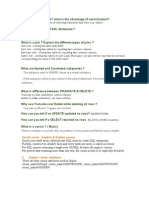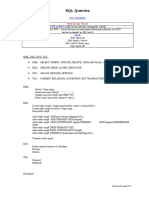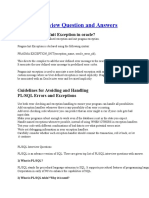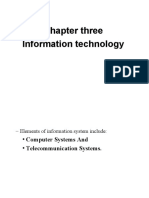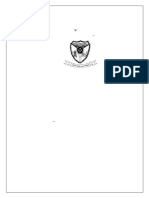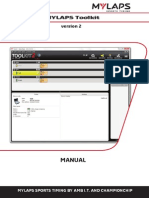1Z0-047 Oracle Database SQL Expert
Uploaded by
Anuj Saxena1Z0-047 Oracle Database SQL Expert
Uploaded by
Anuj Saxenahttp://education.oracle.com/pls/web_prod-plq-dad/ou_certification_css.g...
1Z0-047 Oracle Database SQL Expert
Printer View Exam Number: 1Z0-047 Associated Certifications: Oracle Database: SQL Certified Expert Oracle 11g DBA OCA Oracle 10g DBA OCA Oracle9i DBA OCA Oracle PL/SQL Developer Certified Associate Exam Price: US$ 195 More on exam pricing Exam Registration: Register Duration: 120 minutes Number of Questions: 70 Passing Score: 66% Passing score subject to change. View Details
Recommended Training and Preparation
Additional Information & Resources
Exam Topics
Fraudulent Activity Policy
Recommended Training and Preparation
Oracle University training and preparation: Oracle Database: Introduction to SQL (Bundle) - Bundle may not be available in all regions OR Oracle Database: Introduction to SQL Ed 1 OR Oracle Database: SQL Fundamentals I AND Oracle Database: SQL Fundamentals II
Certification Exam Preparation Seminar: Oracle Database SQL PREVIEW BUY NOW These earlier courses are still valid exam preparation tools but are no longer being scheduled: Oracle Database 10g: Introduction to SQL Oracle Database 11g: Introduction to SQL Oracle Database 10g: SQL Fundamentals I AND Oracle Database 10g: SQL Fundamentals II Oracle Database 11g: SQL Fundamentals I AND Oracle Database 11g: SQL Fundamentals II Exam 047 has been validated against Oracle Database 10g and Oracle Database 11g. Training on either version will be appropriate preparation. The exam has been validated against Oracle Database 11g Release 2 version 11.2.0.1.0
Additional Information & Resources
Material on the topics "Generating Reports by Grouping Related Data" and "Hierarchical Retrieval" are found in the Appendix of the Oracle Database 11g training manuals that accompany the Recommended Training courses. Practice Exams
Oracle authorized practice exam from Self Test Software. 1Z0-047 Oracle Database SQL Expert Oracle authorized practice exam from Transcender: Cert-1Z0-047 DBCert: Oracle Database SQL Expert
Exam Retake Policy Sample Questions
Exam Topics
Retrieving Data Using the SQL SELECT Statement [ ] List the capabilities of SQL SELECT statements [ ] Execute a basic SELECT statement [ ] Describe how schema objects work Restricting and Sorting Data [ ] Limit the rows that are retrieved by a query [ ] Sort the rows that are retrieved by a query Row Functions to Customize Output [ ] Describe various types of functions that are available in SQL [ ] Use character, number, and date functions in SELECT statements [ ] Describe the use of conversion functions Reporting Aggregated Data Using the Group Functions [ ] Identify the available group functions [ ] Describe the use of group functions [ ] Group data by using the GROUP BY clause [ ] Include or exclude grouped rows by using the HAVING clause Displaying Data from Multiple Tables Displaying Data from Multiple Tables [ ] Describe set operators [ ] Use a set operator to combine multiple a single query [ ] Control the order of rows returned Manipulating Data [ ] Describe each data manipulation language (DML) statement [ ] Insert rows into a table [ ] Update rows in a table [ ] Delete rows from a table [ ] Control transactions Using DDL Statements to Create and Manage Tables [ ] Categorize the main database objects [ ] Review the table structure [ ] List the data types that are available for columns [ ] Create a simple table [ ] Explain how constraints are created at the time of table creation Creating Other Schema Objects [ ] Create simple and complex views Manipulating Large Data Sets [ ] Manipulate data using subqueries [ ] Describe the features of multitable INSERTs [ ] Use the following types of multitable INSERTs (Unconditional, Conditional and Pivot) [ ] Merge rows in a table [ ] Track the changes to data over a period of time Generating Reports by Grouping Related Data [ ] Use the ROLLUP operation to produce subtotal values [ ] Use the CUBE operation to produce crosstabulation values [ ] Use the GROUPING function to identify the row values created by ROLLUP or CUBE [ ] Use GROUPING SETS to produce a single result set Managing Data in Different Time Zones [ ] Use Various datetime functions Retrieving Data Using Subqueries [ ] Write a multiple-column subquery [ ] Use scalar subqueries in SQL [ ] Solve problems with correlated subqueries
1 of 2
8/21/2012 12:32 PM
http://education.oracle.com/pls/web_prod-plq-dad/ou_certification_css.g...
[ ] Write SELECT statements to access data from more than one table using equijoins and nonequijoins [ ] Join a table to itself by using a self-join [ ] View data that generally does not meet a join condition by using outer joins [ ] Generate a Cartesian product of all rows from two or more tables Using Subqueries to Solve Queries [ ] Define subqueries [ ] Describe the types of problems that subqueries can solve [ ] List the types of subqueries [ ] Write single-row and multiple-row subqueries
[ ] Retrieve data from views [ ] Create, maintain, and use sequences [ ] Create and maintain indexes [ ] Create private and public synonyms Managing Objects with Data Dictionary Views [ ] Use the data dictionary views to research data on your objects [ ] Query various data dictionary views Controlling User Access [ ] Differentiate system privileges from object privileges [ ] Grant privileges on tables [ ] View privileges in the data dictionary [ ] Grant roles [ ] Distinguish between privileges and roles Managing Schema Objects [ ] Add constraints [ ] Create indexes [ ] Create indexes using the CREATE TABLE statement [ [ [ [ ] ] ] ] Creating function-based indexes Drop columns and set column UNUSED Perform FLASHBACK operations Create and use external tables
[ ] Update and delete rows using correlated subqueries [ ] Use the EXISTS and NOT EXISTS operators [ ] Use the WITH clause Hierarchical Retrieval [ ] Interpret the concept of a hierarchical query [ ] Create a tree-structured report [ ] Format hierarchical data [ ] Exclude branches from the tree structure Regular Expression Support [ ] Using Meta Characters [ ] Regular Expression Functions [ ] Replacing Patterns [ ] Regular Expressions and Check Constraints
BACK TO TOP
Oracle Certification Program Fraudulent Activity Policy
Oracle reserves the right to take action against any candidate involved in fraudulent activities, including, but not limited to, fraudulent use of vouchers, promotional codes, reselling exam discounts and vouchers, cheating on an exam, alteration of score reports, alteration of completion certificates, violation of exam retake policies or other activities deemed fraudulent by Oracle. If Oracle determines, in its sole discretion, that fraudulent activity has taken place, it reserves the right to take action up to and including, but not limited to, decertification of a candidate's Oracle Certified Associate, Oracle Certified Professional and/or OCM credentials, temporary, indefinite or permanent ban of a candidate from Oracle certification programs, notification to a candidate's employer, and notification to law enforcement agencies. Candidates found committing fraudulent activities forfeit all fees previously paid to Oracle, or to Oracle's authorized vendors, and may be required to pay additional fees for services rendered. View the Oracle Certification Program Candidate Agreement which requires your agreement before the start of each exam.
2 of 2
8/21/2012 12:32 PM
You might also like
- How To Make Money in Intraday Trading - A Master Class by One of India - S Most Famous Traders87% (102)How To Make Money in Intraday Trading - A Master Class by One of India - S Most Famous Traders279 pages
- Oracle 12C - (SQL & PL/SQL) : 1.fundamentals of DatabaseNo ratings yetOracle 12C - (SQL & PL/SQL) : 1.fundamentals of Database8 pages
- Oracle Database Administration Interview Questions You'll Most Likely Be Asked: Job Interview Questions SeriesFrom EverandOracle Database Administration Interview Questions You'll Most Likely Be Asked: Job Interview Questions Series5/5 (1)
- Organisational Behaviour by Margie Parekh and Rajen Gupta50% (2)Organisational Behaviour by Margie Parekh and Rajen Gupta4 pages
- Earlywatch Alert - P01 1 Service SummaryNo ratings yetEarlywatch Alert - P01 1 Service Summary78 pages
- Scenario: Executive Summary of Class Scheduler SystemNo ratings yetScenario: Executive Summary of Class Scheduler System8 pages
- Oracle Database 11g - SQL Fundamentals I - Oracle Certification Exam100% (1)Oracle Database 11g - SQL Fundamentals I - Oracle Certification Exam2 pages
- What Is Difference Between TRUNCATE & DELETE?: Oracle PL SQL Interview Questions For 3+ YearsNo ratings yetWhat Is Difference Between TRUNCATE & DELETE?: Oracle PL SQL Interview Questions For 3+ Years16 pages
- Lab 7 PL/SQL: IS221: Database Management Systems100% (1)Lab 7 PL/SQL: IS221: Database Management Systems36 pages
- Oracle - Premium.1z0 148.by .VCEplus.20q DEMONo ratings yetOracle - Premium.1z0 148.by .VCEplus.20q DEMO19 pages
- 2016 New 1Z0 061 Exam Dumps For Free VCE and PDF 31 450% (1)2016 New 1Z0 061 Exam Dumps For Free VCE and PDF 31 4511 pages
- PL/SQL Interview Question and Answers: What Is Pragma Init Exception in Oracle?No ratings yetPL/SQL Interview Question and Answers: What Is Pragma Init Exception in Oracle?4 pages
- Complete Oracle Database Administration Course (19C, 21C) - UdemyNo ratings yetComplete Oracle Database Administration Course (19C, 21C) - Udemy8 pages
- 90 REAL TIME PL SQL Interview Questions and Answers List of Top 90 PLSQL Interview Questions and Answers For Freshers Beginners and Experienced PDF0% (1)90 REAL TIME PL SQL Interview Questions and Answers List of Top 90 PLSQL Interview Questions and Answers For Freshers Beginners and Experienced PDF25 pages
- Top 50 Oracle Interview Questions and AnswersNo ratings yetTop 50 Oracle Interview Questions and Answers51 pages
- Oracle Database 12c Database SQL 1Z0 071 Exam+ (2018!06!30)No ratings yetOracle Database 12c Database SQL 1Z0 071 Exam+ (2018!06!30)75 pages
- Oracle E-Business Suite Manufacturing & Supply Chain ManagementFrom EverandOracle E-Business Suite Manufacturing & Supply Chain ManagementNo ratings yet
- Interim Union Budget 2019-20 - Budget Review-4 Feb 2019No ratings yetInterim Union Budget 2019-20 - Budget Review-4 Feb 201911 pages
- Funds Update: IL&FS Group Related ExposuresNo ratings yetFunds Update: IL&FS Group Related Exposures6 pages
- Interim Union Budget 2019-20 - Budget Review-4 Feb 2019No ratings yetInterim Union Budget 2019-20 - Budget Review-4 Feb 201911 pages
- Market Mantra: Bata India (Buy Between Rs1183-1189, Target Rs1207, Stop Loss Rs1174.75)No ratings yetMarket Mantra: Bata India (Buy Between Rs1183-1189, Target Rs1207, Stop Loss Rs1174.75)8 pages
- Stock Name Vindhya Telelinks Limited: Business PromotersNo ratings yetStock Name Vindhya Telelinks Limited: Business Promoters2 pages
- H-E-B Own Brands - Retail Case - 121590978No ratings yetH-E-B Own Brands - Retail Case - 12159097821 pages
- If Two Independent Activities Are There in Precedence Column Together, Then Dummy Example: LC/ESNo ratings yetIf Two Independent Activities Are There in Precedence Column Together, Then Dummy Example: LC/ES2 pages
- Report GV Research - Athletic Footwear Market AnalysisNo ratings yetReport GV Research - Athletic Footwear Market Analysis22 pages
- Jayamukhi Institute of Technological Sciences (Autonomous) M.Tech. (Software Engineering) Course Structure and Syllabus I Year - I SemesterNo ratings yetJayamukhi Institute of Technological Sciences (Autonomous) M.Tech. (Software Engineering) Course Structure and Syllabus I Year - I Semester70 pages
- Artificial Intelligence Systems in AviationNo ratings yetArtificial Intelligence Systems in Aviation27 pages
- It3511 - Full Stack Web Development - Faculty - ManualNo ratings yetIt3511 - Full Stack Web Development - Faculty - Manual117 pages
- 2.1 Review of Literature: "SQL Generation and PL/SQL Execution From Natural Language Processing"No ratings yet2.1 Review of Literature: "SQL Generation and PL/SQL Execution From Natural Language Processing"11 pages
- IBM Data Studio and IBM DB2 LUW Database: Management GuideNo ratings yetIBM Data Studio and IBM DB2 LUW Database: Management Guide32 pages
- Optimizer Statistics: Julian Dyke Independent ConsultantNo ratings yetOptimizer Statistics: Julian Dyke Independent Consultant105 pages
- MS SQL Server: Beginner To Advance TutorialNo ratings yetMS SQL Server: Beginner To Advance Tutorial27 pages
- Keynote: The Disrupting Effects of SAP HANA and In-Memory DatabasesNo ratings yetKeynote: The Disrupting Effects of SAP HANA and In-Memory Databases35 pages
- SQL - 2 - HTML: Automatic Generation of HTML Database Schemas: Jon Finke Rensselaer Polytechnic InstituteNo ratings yetSQL - 2 - HTML: Automatic Generation of HTML Database Schemas: Jon Finke Rensselaer Polytechnic Institute7 pages
- Advanced Shipping Configuration With Websphere Commerce Calculation FrameworkNo ratings yetAdvanced Shipping Configuration With Websphere Commerce Calculation Framework49 pages
- Smart School Bus: Iot Based School Bus Monitoring System: Presented byNo ratings yetSmart School Bus: Iot Based School Bus Monitoring System: Presented by42 pages












